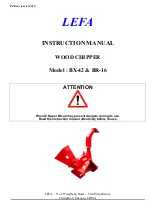
Page 45
14.5
START UP PROCEDURE
1) With the switch closed, open the electrical panel and exclude compressor (refer to the
wiring diagram on the unit). Close the panel, set switch to “ON” (to give power to the unit).
2) Wait for the start of the microprocessor and control. Make sure that the temperature of the oil
is hot enough. The oil temperature must be at least 5°C higher than the saturation
temperature of the refrigerant inside the compressor.
3) Place the unit in the “ON” and wait until the unit is indicated on the display-On.
4) Turn on the pumps (at max speed if with inverter).
5) Verify that the loss of load of the evaporator is equal to that of the project and correct if necessary.
The pressure drop on the evaporator must be read on the service valves installed on the evaporator
piping as a standard. Do not measure the load losses in points where any valves and / or filters are
interposed.
6) Check for air in cleaning filters, and then drain the system.
7) Return the pump to the factory setting.
8) Turn off the power (into standby mode) and make sure the pumps stop after about 2
minutes.
Verify that the local temperature set point is set to the required value by pressing the Set
button.
9) Turn the main switch to “OFF”. Open the cabinet. Reactivate the compressors. Close the
cabinet. Turn the main switch to “ON” (to give power to the unit).
10) Wait for the start of the microprocessor and control.
11) When the compressor is started, wait about 1 minute for the system begins to stabilize.
12) Check the pressure of evaporation and condensation of refrigerant.
13) Verify that, after a period of time necessary for the stabilization of the refrigerant circuit, the
liquid indicator placed on the inlet pipe to the expansion valve is completely filled (no bubbles),
and that the moisture indicator signs ‘Dry’. The passage of bubbles within the liquid indicator
may indicate a low amount of refrigerant, or an excessive pressure drop through the filter
drier, or an expansion valve blocked at the maximum opening position
14) In addition to checking the sight glass, check the operating parameters of the circuit
controlling:
a) Overheating compressor
b) Overheating compressor discharge
c) Sub-cooling of the liquid exiting the remote condenser
d) Evaporation pressure
c) Condensing pressure
15) Measure the values of pressure and temperature by means of the suitable instrumentation
and make comparison by reading the corresponding values directly on the display of the
microprocessor on board
16) To temporarily turn off the unit put on standby the unit key or open the remote contact
(terminals shown in the wiring diagram provided with the unit) of the terminal X (by means of a
remote switch installed by the customer) or set time zones. The microprocessor will activate
the shutdown procedure that will take a few seconds. The unit water pump will be running on
for two minutes after the unit has been switched off. Do not remove the main power to not turn
off the electrical resistances of the compressor and the evaporator.
15
MAINTENANCE
Maintenance operations are fundamental in order to keep the units running properly, from both a
purely functional and an energetic points of view.
Every Trane CCUF unit comes with a logbook, in which the user or the person delegated to
machine maintenance can keep all the required notes, in order to keep a historical log of the
Trane CCUF unit.
A lack of notes in the logbook could be considered proof of careless maintenance.
Summary of Contents for CCUF
Page 26: ...Page 26 USER SIDE...
Page 28: ...Page 28 USER SIDE...









































